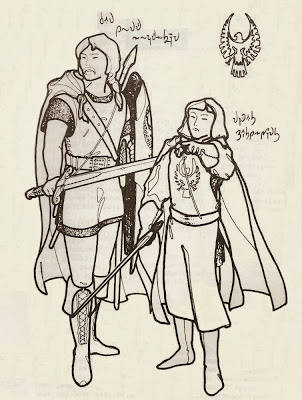 |
|
For
those illiterate in Mystic Swamp Elvish, the tall one is Sir Tarl
Eaglemoor
and the other guy is Robin Winterthorn. No, seriously.
|
The first page of the Wizards' Realm rulebook has a list of contents. It's not a Table of Contents because that would require page references. I suppose it's just as well since the errata tells us that “Pages 15 and 50 were juxtaposed in printing.” (At least the rulebook has an index.) About half of the skill descriptions are on what should have been page 15. In effect, the skill listings start on page 14, jump to page 50, and conclude on page 16. Skills are a fundamental part of a Wizards' Realm character; they encompass such things as spells and ability to use different weapon types.
I agree completely that player characters should start out weak – but not too weak – then grow in power with experience. However, in Wizards' Realm, beginning characters are weak (perhaps too weak), but amass power at a fast rate (perhaps too fast). We will see an example of this in next week's post.
Wizards' Realm is a level-based system, except “levels” are called “degrees.” (Some instances of “level” still remain in the text.) Player Characters start the game with 3 'Skill Credits' and gain more with experience. At lower degrees, PCs receive 4 Skill Credits per degree. Starting at sixth degree and continuing through eleventh, they get 6 Skill Credits per degree; from twelfth through twentieth, eight Skill Credits. There are no degrees after twentieth; however, characters at twentieth level can obtain an additional Skill Credit for every thousand Experience Points earned. Aside from gaining Skill Credits, advancing from one degree to another does not provide any intrinsic advantage to a character. (One exception being spellcasting effectiveness – see below). Abilities improve only to the extent Skill Credits are applied.
Skill Credits can be applied in various ways. One Skill Credit per degree can be used to increase the value of an Attribute (up to a maximum value of 25). So that means it takes same amount of effort (i.e., one Skill Credit) to change an Attribute value from three to four or from twenty-three to twenty-four – a linear progression.
Spellcasters can use a Skill Credit to gain a spell. The percentage chance of effectiveness of a given spell is based upon the level of the spellcaster and the complexity of the spell. Additional Skill Credits spent on the same spell apply a 10% bonus to the effectiveness (to a maximum of 99%). At certain degrees, spellcasters automatically improve their effectiveness with all spells.
A Skill Credit spent on a 'professional skill' – which I understand to be any skill that is neither a weapon skill nor a spell – grants a 50% proficiency. A second Skill Credit spent on a professional skill gives +15%; each Skill Credit spent thereafter on that skill gives +10% (to a maximum of 99%). High (or low) Attribute values do not affect proficiency chances. Among the professional skills, there are 'silversmithing,' 'apothecary science,' 'tracking,' 'social graces,' 'stealth,' 'detection of lies,' and...'mime.'
Finally, there are weapon skills. Each weapon has a fixed damage value; so-called “contact weapons” also have a defense bonus and an “initiation” bonus. (Initiative is not determined in Wizards' Realm combat, instead there is “initiation.”) One Skill Credit used for a weapon skill gives 'half' proficiency. A character who is half-proficient with a weapon only uses half of the damage, defense, and initiation values listed for a weapon. With two Skill Credits applied, a character obtains full benefit from the various values provided by the weapon. This suggests that a character without any training in a weapon disregards all values of the weapon. With a good combat roll, such a character can still cause damage with the weapon, but the weapon's damage value will not be applied. Once a character has 'full' proficiency with a weapon, he or she can “develop phenomenal ability” by spending additional Skill Credits. A character receives +1 to damage (and, for contact weapons, defense) for each Skill Credit spent (after obtaining full proficiency) to a maximum of +5.

























